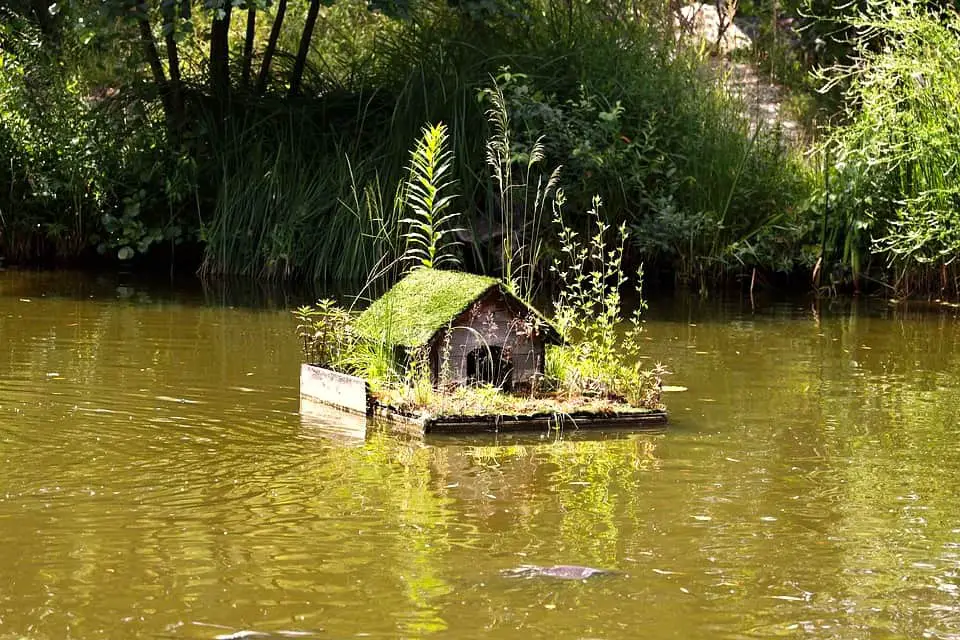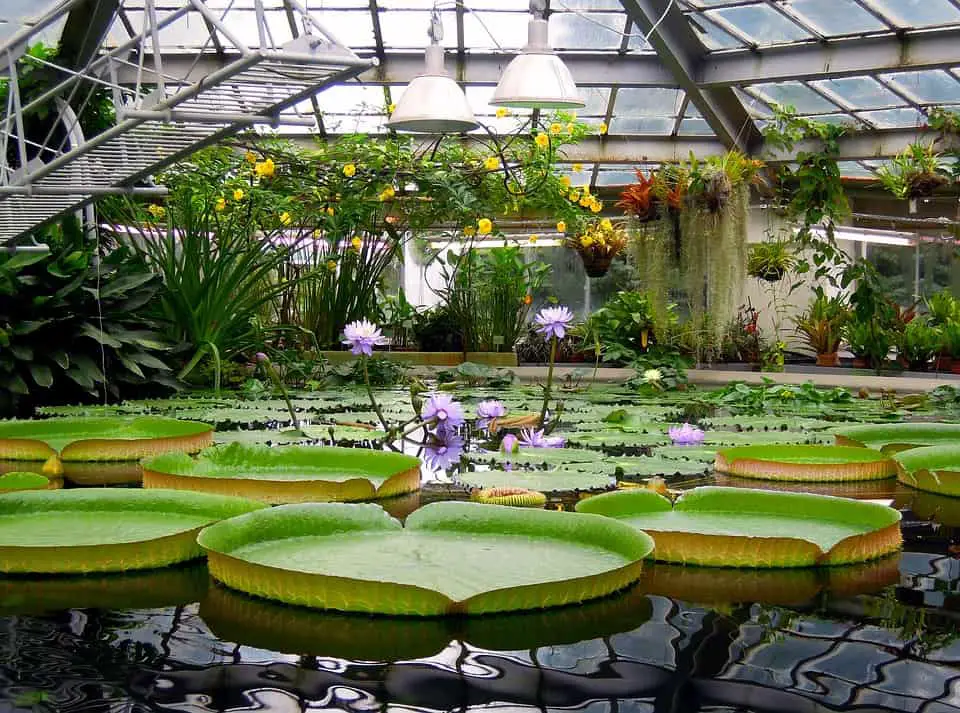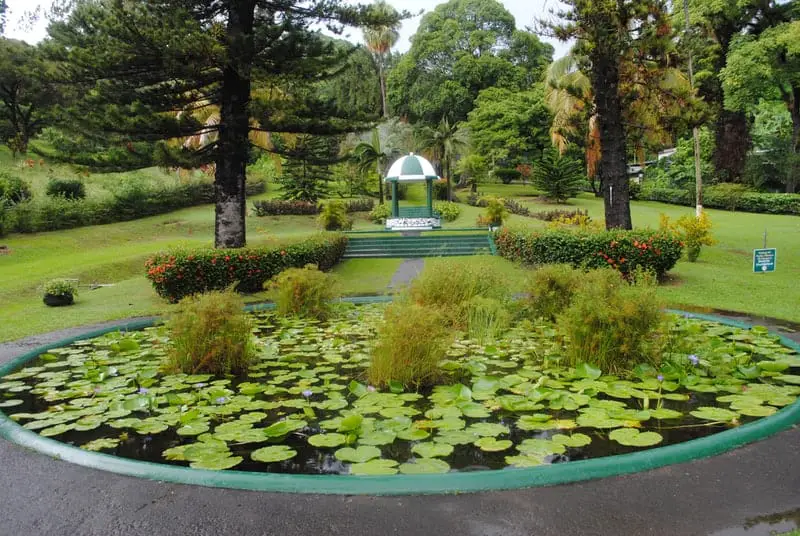Nutrient pollution and sunlight cause the overgrowth of algae. High nutrient levels and other chemical pollutants can be a severe and critical burden for many of our natural waterways, especially in the more industrialized parts of the world. Floating plant islands are a natural, economical, and effective way to treat all types of water. Plants chosen for the plant islands should be based on the plants’ phytoremediation abilities and matched to the cleaning needs of the water.
According to the EPA, nutrient pollution is one of the most costly and pervasive environmental problems in the country. The use of artificial floating plant islands began as a natural way to treat wastewater about 40 years ago in North America and is currently a popular method used in Asia.
The floating plant island’s design is to provide a porous yet buoyant floating surface that will support the weight of the growing plants and allow the roots to pass through the island to hang down into the water. There are many different designs, but they all work about the same.
The islands can be placed linked together as a group or individually on the water’s surface. Either way, the islands do a great job of filtering water, and they look like a beautiful island of plants once they have grown in.
They are ideal for ponds with no planting shelves, ponds that are too deep to grow aquatic marginals, and any natural bottomed body of water where it is not practical or desired to plant into the shoreline.
How do Floating Plant Islands Help?
The islands remove nutrients from the water using the plants on top of them. The plants absorb the nutrients for growth, while the underwater root systems trap solids. Bacteria can form on the plants and floating structures that remove the nutrients using chemical processes.
Floating Treatment Wetlands
Some floating plant islands are also called floating treatment wetlands (FTWs), or human-made floating wetlands. These FTW’s are typically more than just a simple flat plant island but are instead crafted with more flotation to allow for a more varied island structure allowing for a more diverse assortment of plants and animals to thrive. As with any natural ecosystem, diversity is king.
Floating treatment wetlands, being larger, more diverse, and more buoyant, can be used to treat bigger problems in much more harsh environments than a standard plant island can. In addition to treating water, the FTW’s can also be used to control water flow and help protect shorelines from erosion.
The porous, fine material allows water in, prevents soil from entering the pond, and protects plants from fish. It is constructed to float at the pond’s surface and provides attractive options for showcasing your favorite aquatic plants.
Floating islands create a habitat on the water, which acts as a purifier. Plant growth is encouraged both below and above the waterline, allowing for wetland and terrestrial plants to grow. This enables a variety of plant species to purify the water in ponds, canals, and lakes.
Pick the size of the island you want

Floating islands come in all shapes and sizes. The size you choose should depend on the types and number of plants you want on the island. The bigger the plant mass, the bigger the island you will need.
Installation of a Floating Island

You don’t need specialized equipment to install a plant island, but a small boat might be helpful, depending on the size of your pond. Plant the islands on the shore and push them into the water. What could be easier? Most floating plant islands, both large and small, are anchored to the bottom of the body of water, but sometimes they are tethered to the shore or each other to keep them in place.
A floating island is a simple way to add aquatic plants to your pond for beauty and the benefits they provide. The islands can be constructed in many different ways, but the one thing they all have in common is that they must float, and they must allow the plant roots to hang through into the water.
Choose a location in your pond.
Where to put it? That is your choice entirely. It is typically placed toward the middle of the pond, but as long as it is in the water, it is fine. More water flow is better; the plants will grow more quickly and remove more nutrients in moving water than still water. Enjoy its beauty! It is a living and cleaning piece of art — enjoy it.
Planting a Floating Island
Planting a floating island is easy. You can make it as simple or ornate as you desire. Just put the plants into the fibrous material of the island. Once in the water, the plant roots will quickly grow into the water. If planting terrestrial plants, you will likely need a bit of soil on top of the island. If planting only aquatic plants, no soil is required.
Here are a few guidelines to get started
Choose moisture-loving plants
- The plants you choose must tolerate moist soil and shallow water conditions. You can certainly add terrestrial plants to the island, but they will need to be higher out of the water than the aquatic plants.
- The only aquatic plants that will not work on an island are ones needing deep water, such as water lilies. Also, be aware that small plant islands with tall plants may tend to roll over, so plan accordingly.
- For aesthetic appeal, place the focal-point, taller plants in the middle and surround them with ground cover plants along the edges. Plants that creep and spill over the sides work exceptionally well for floating islands because they hide the island’s foam edges.
Here are some suggestions of the ground covers that can be used.
- Blue Creeping Mazus
- Blue Moneywort
- Creeping Jenny
- Golden Creeping Jenny
- Red Rotala
- Variegated, Crystal Confetti Pennywort
- Water Pennywort
- White Creeping Mazus
- Aquatic mint
- Aquatic celery
Here are some suggestions for the taller plants you can use
- Blue-Eyed Grass
- Carolina Yellow Jacket Pitcher Plant
- Chameleon Plant
- Dana’s Delight Pitcher Plant
- Horsetail
- Mini Horsetail, Dwarf Scouring Rush
- Red-Stemmed Parrot Feather
- Society Garlic
- Star Grass
- Variegated Society Garlic
- Yellow-Eyed Grass
- Reeds
- Rushes
- Arrowhead
The Hard Working Plants

The plants and their roots have a critical role to play. The long roots are doing two things. They slow down the water movement, help with settling, and the bacteria and microbes get stuck in the sticky biofilm on the roots to clean the water. There are also many benefits to the food chain. Many forms of pond life can make their home in the roots and on top of the island. With time, the plants will all grow together, and other plants are sure to seed themselves into your island, so make sure to use an island with plenty of floatation.
For the ultimate in nutrient and pollution removal from the body of water, the foliage of the plants on the island should be harvested at the end of every season to avoid having them die back and decompose back into the pond water. Roots do not need cutting, but allowing some of the plants’ foliage to die and disintegrate on the island will help begin the natural soil-building process to enrich the island for many years.
Six Midwest Flowers that are Perfect
Here are six Midwest flowers that are perfect for floating plant islands. Multiple species of native plants should be planted to attract diverse birds and insects. Scientific names have been included to help locate them at a nursery if needed.
- Marsh Hibiscus – Hibiscus Laevis
- This northern native plant is also known as Rose Mallow. It grows back every year in the same location. It can grow up to five feet and is a woody bush, which blooms from July to September. It has sturdy wood stems, makes an excellent center anchor for the island, and offers winter habitat if not trimmed.
- Marsh Marigolds – Caltha Palustris
- These are short mounding marigolds that thrive in moist areas. They bloom in early May and can, on occasion, have a few flowers blooming again late in the season. The leaves are dark green.
- Obedient Plant – Physostegia Virginiana
- These plants are common in wetlands and along shorelines and can spread quickly and take over less aggressive plants.
- Rose Milkwood – Asclepias Incarnata
- Butterflies love this tall, straight flower. It varies in height from three to five feet, blooming from mid-to-late summer. It is commonly found along undisturbed marshy areas.
- Sweet Flag – Acorus Americanus
- This yellow and green perennial plant looks like a bigger version of the iris but does not have a standard flower. It has a spathe, which encloses a flower cluster. The sweet flag was a favorite among Native American tribes for use as a medicinal resource. It was also used for ceremonies and trade. It gives off a lovely fragrance when the leaves are broken.
- Wild Iris — Versicolor Iris
- An iris is one of the first flowers to bloom in the spring of the year. The blue and purple flowers fade quickly, but the plant excels in providing a lovely backdrop for shorter summer flowers. Wild iris love to be wet, so they are perfect on a floating island with constant water access.
Planting tips
- Planting native aquatic perennial herbs is a great idea.
- Plants must be able to tolerate full sun.
- Do not introduce species onto the island that is non-native or invasive.
- After several years, nature will become the gardener, so don’t sweat it when new plants show up.
- The islands can stay in the water year-round. Repeated freezing and thawing cycles do not harm them.
- Plant islands can be excellent nesting habitat for birds. If you don’t want aquatic birds nesting on your island, you may want to install light fencing around the perimeter.
- Avoid flowering plants that are “tasty,” such as lilies or nasturtium, as they may attract muskrats.
The Effectiveness of Floating Plant Islands in Filtering Water
Floating plant islands are great at cleaning up wastewater because they filter out metals, pathogens, nutrients, and other water contaminants. Why invest billions of dollars in building new wastewater treatment facilities when there is a natural and environmentally-friendly way to solve the problem. Plus, it is a low-cost and highly effective way to deal with nutrient pollution in smaller ponds without harmful chemicals.
These plant islands are like “floating water treatment plants,” combining the greenery you would see in a traditional wetland with some human-made technology to keep it afloat.
There is a sticky biofilm that will form on the island and the roots below the island. It grabs microbes and bacteria which colonize to disintegrate the pollutants, and as they are at the beginning of the food chain, they will be fed on by fish and other organisms. The islands provide diverse habitats above, inside, and below the water.
The floating island provides a place for bacteria and microbes to colonize by adding a tremendous amount of surface area and an excellent place for them to flourish. While they grow, they are active and moving, which is when the pollutants in the water are breaking down. The dirtier the water is, the more active the microbes are, the more water is being cleaned.
Floating islands are an easy way for us to mimic the wetlands and bogs that have been cleaning the earth’s water since time began.
Why Are Wetlands and Bogs Important?
Marshes, swamps, and other water-soaked lands link organisms in water and land in a way that permits them to co-exist naturally. As water moves through the plants’ roots, it is naturally and efficiently cleaned by the plants and the multitude of organisms that thrive in their root masses. It is unfortunate, but wetlands are being replaced rapidly for agricultural or urban development, depriving the earth and its waters of many countless acres of filtration that have for so long protected our precious groundwater and aquifers.
Here are a few facts about the importance of wetlands.
- Wetlands are similar to human kidneys. Our kidneys extract waste from the blood and balance bodily fluids. The wetlands can clean the water that flows through them, mitigate large flood events, and recharge the underground aquifers.
- Wetlands also provide fisheries and timber resources, protect coastal communities from extreme weather events such as hurricanes and typhoons, and provide a habitat for biodiversity.
- Wetlands can lessen climate change. Coastal wetlands such as mangrove forests store large quantities of blue carbon in the vegetation. “Blue carbon” is stored naturally by marine and coastal ecosystems. These ecosystems hold a lot of carbon. An area of a mangrove forest can store up to ten times as much carbon as a land-based forest of the same size. It is vital to conserve and protect the blue carbon because its release of carbon dioxide (CO2) into the atmosphere is a significant cause of climate change.
- Wetlands are a habitat for biodiversity as the species found there are some of the most unique in the world. They have evolved specifically to survive in these hydrologically changing ecosystems. Muskrats, alligators, nutrias, crocodiles, fish species, and hundreds of birds such as geese, mallards, and herons are found in wetlands. There are more than 800 protected migratory birds in the United States, and more than half of them rely on the wetlands.
- The vegetation located in wetlands has evolved to survive in seasonal flooded and saline conditions, making it unique as well. Examples of this are mangrove species in coastal wetlands and cattails in freshwater wetlands.
- Threats to the wetlands continue as many of them are being drained, destroyed, and replaced with commercial, residential, urban, or agricultural development. The destruction of the wetlands negatively impacts millions of people dependent on the ecosystem’s services.
Wetlands are known to clean water. Thick vegetation traps excess nutrients and heavy pollutants and keeps waterways free and clear. Unfortunately, many rivers and lakes no longer have wetlands. They are the first to be eliminated when planners need more real estate areas to develop.
Wetlands improve water quality in stormwater runoff and manage watershed nutrients. They are beneficial to the treatment of wastewater and other industrial contaminants. Wetlands rely on a natural process to filter water biologically. It passes through permeable bottom soils and shallow areas of dense aquatic vegetation.
The nutrients are removed by the uptake of microbes and plants, assimilated, absorbed into inorganic and organic sediments, then converted into gas by dissolving. The aquatic plants above and below the water take up these elements and remove them from the sediment and water column into the biomass or plant material.
How These Floating Plant Islands Can Help Ponds
The two most significant benefits are improved water quality and the diverse habitat. The floating wetlands reduce algae by cycling nitrogen and phosphorus. They reduce suspended solids which are the cause of cloudy water.
The second main benefit of creating diverse habitat is “above the island,” “on the island,” and “below the island.” Frogs and turtles are attracted to the surface of the island. Plants appealing to pollinators, such as butterflies, bees, beetles, flies, bumblebees, and honeybees, should be planted. For example, if you live in an area where monarch butterflies are plentiful, plant swamp milkweed. Other plants that are important for the birds and bees will help them with a nutritional plant they may not encounter in an individual’s garden.
Pond plants provide oxygen enabling fish and other animals such as aquatic insects and other small creatures to live in the pond by providing food and shelter. In larger water bodies, aquatic plants help reduce wave action, preventing erosion.
There are numerous organisms living in the porous holes of the island. The organisms, or macroinvertebrates, are essential. The island will double in weight during the first year because so many of them and other animal species live on the island.
Shoreline Protection
Many people value islands for the protection of the shoreline. For example, in Gulf areas, floating islands offer shoreline protection to help restore the marshes by reducing the wave chop.
They can also be used for soft-scaping and beautification. In urban areas where there are metal walls along some waterways, the floating islands provide a natural habitat and make the waterway more attractive.
Aeration
Adding aeration below floating islands is an excellent way to improve your floating island’s efficiency. Lake bottom aeration below the island provides an oxygenated environment where aerobic bacteria thrive. The biofilm, which forms under the islands’ surface, colonizes the biofilter and becomes the habitat for billions of beneficial bacteria. The bacteria consume excess nutrients in the water, creating the water’s perfect treatment. More oxygen and more water movement will equal more efficiency and more water clean-up.
Natural Pond Balance Works

Most people do not have the patience to wait for nature to take its course. That is why so many companies promote the use of chemical applications for pond maintenance. The products they sell are poisoning our water. It becomes a vicious cycle of killing the algae with chemicals. The dead algae go to the bottom, creating more nutrients for the next algae bloom when the chemicals wear off. This is why most natural bottomed retention ponds are a nightmare for their owners – chemicals and thick sludge stay on the bottom of the pond.
But done the natural way, the pond eventually does very well on its own. And without our help!
Install a plant island in your pond today and take one massive step toward maintaining your backyard pond, retention pond, or golf course pond naturally.

